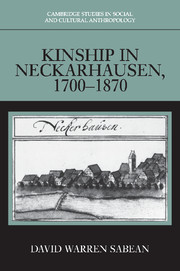Book contents
- Frontmatter
- Contents
- List of tables
- Abbreviations
- Abbreviations of sources
- On reading kinship diagrams
- Glossary
- Preface
- Introduction
- Cohort I (1700–1709)
- Cohort II (1740–1749)
- Cohort III (1780–1789)
- Cohort IV (1820–1829)
- Cohort V (1860–1869)
- 17 Kinship in the mid-nineteenth-century village: An introduction
- 18 Networking with kin around the mid nineteenth century
- 19 Matrifocal alliance
- Conclusion
- Appendix
- Bibliography
- General index
- Index of villagers
18 - Networking with kin around the mid nineteenth century
Published online by Cambridge University Press: 04 August 2010
- Frontmatter
- Contents
- List of tables
- Abbreviations
- Abbreviations of sources
- On reading kinship diagrams
- Glossary
- Preface
- Introduction
- Cohort I (1700–1709)
- Cohort II (1740–1749)
- Cohort III (1780–1789)
- Cohort IV (1820–1829)
- Cohort V (1860–1869)
- 17 Kinship in the mid-nineteenth-century village: An introduction
- 18 Networking with kin around the mid nineteenth century
- 19 Matrifocal alliance
- Conclusion
- Appendix
- Bibliography
- General index
- Index of villagers
Summary
Thus far, this book has been mapping a series of activities that linked different individuals and families together. Perhaps the term “territorialization” best emphasizes the fact that each set of transactions had its own terrain and lines of communication. At the beginning of the eighteenth century, for example, godparentage, marriage, and guardianship connected people together in quite different ways and followed paths that were constructed for different purposes, at different times, and in different areas. At the same time, the topography of communication was shaped by a few major routes that gave definition to the landscape and provided certain access points or places of departure for various kinds of commerce. At the beginning of the eighteenth century, marriage alliance and ritual kinship offered alternative means for linking networks, but by the mid nineteenth century, selection of godparents by and large followed trails already well marked out by marriage.
As a group, the institutions under consideration in this study were subject to increasing “familialization” and became more interconnected. And clearer definition was given to a group of kin extending out to cousins who could be called upon by individuals and families for a variety of tasks. As Chapter 19 shows, the tendency to marry close consanguineal kin continued to increase at least up through the 1860s, and cousins continued to play an important role as godparents.
- Type
- Chapter
- Information
- Kinship in Neckarhausen, 1700–1870 , pp. 368 - 378Publisher: Cambridge University PressPrint publication year: 1997



